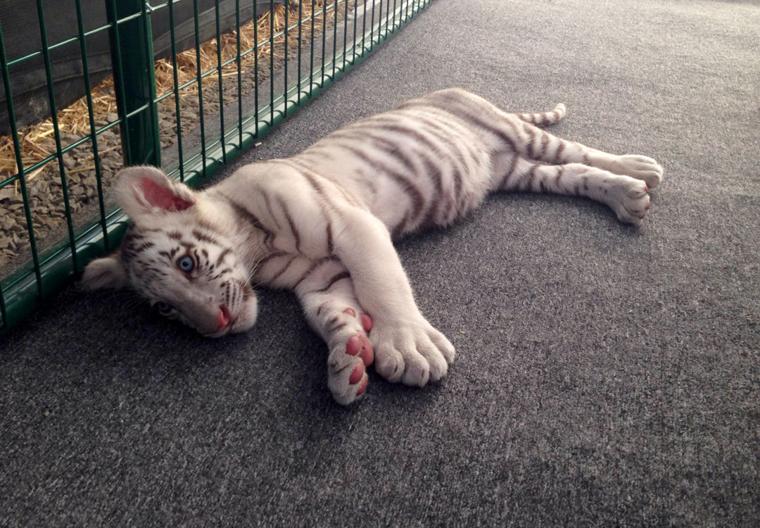By Erin Keane WFPL News | Posted: Wednesday, November 12, 2014

Tiger cub
A tiger cub rests at Wildlife in Need Inc. near Charlestown.
Of course not — Trumbaturi, who works for a Louisville marketing firm, is a Tiger herself, a graduate of Louisiana State University, whose iconic tiger mascot Mike (currently in his sixth incarnation) rides through Tiger Stadium in a cheerleader-topped cage before the start of home football games.
Trumbaturi and a group of friends recently visited Wildlife in Need’s facility in rural Charlestown. She was intrigued by the organization and the opportunity to play with the cubs. For many, the lure of being able snuggle or rough-house with the baby version of a wild predator is strong — something about that mixture of danger and lethal cuteness seems to override any questions people might otherwise have about best practices for captive wildlife.
Kelly Donithan, a wildlife rescue program officer with the International Fund for Animal Welfare, said even when people understand that the practice can be problematic, the temptation is hard to ignore. “It’s difficult because it’s such an intriguing opportunity for people,” she said. “I think most people love animals. And they see them, and they want to get close.”
In July, Trambaturi bought a $25 ticket online, gathered in a tent outside the gates of the main tiger sanctuary, and watched owner Tim Stark bring a few tiger cubs out for open play time on the carpeted floor. It was fun at first, Trumbaturi said. She even petted one of the cubs, just long enough to feel his fur. “It turned strange when it was time to pose with them,” she said.
After a vigorous playtime session, Stark passed out bottles of milk and asked guests to bottle-feed the cubs. They drank for a minute or two and fell asleep, or at least grew drowsy enough to lie still while people crawled around them to snap photos with the cubs on the floor. Later, guests paid an additional fee to pose for more photos with the tigers on their laps.
Baby Tiger Playtime occurs at county fairs and flea markets across the country in areas where it’s legal. And it’s a money-maker. Stark said he realized last year that he needed to bring in more paying visitors to help renovate his space and keep the facilities running. It’s working — Wildlife in Need’s income jumped from about $54,000 in 2012 to more than $184,000 the following year, when playtime took off. “Tiger Baby Playtime shows booked solid for [explicative] 10 weeks straight,” he said in an interview. “Every show we’ve put on, 35 people, plus. Every hour, booked solid.”
Over the summer, along with Tiger Baby Playtime, Stark offered other animals for hands-on interaction. The concurrent program made otters, monkeys, lemurs — even a baby brown bear available — but they didn’t draw the crowds the way baby tigers did. “At the time, it seemed like I learned a thing or two about tigers, although I can’t recall at the moment. It gave me a deeper appreciation for the size and strength of the cats, so big even at such a young age,” Trumbaturi said.
Since her visit, Trumbaturi has heard about complaints made against Stark, like People for the Ethical Treatment of Animals’ recent allegations of mistreatment. “If they are treating the tigers in a way not accepted as standard, acceptable, then yes, it does bother me and I wouldn’t support them again,” she said. “But I’d want to know all the facts first, because I think if done correctly, there is a place for this sort of stuff. But again, if done in a humane manner.”
One of the criticisms levied at these kinds of events is that they create more mouths to feed, much like how a spike in dog breed popularity eventually creates more backyard-bred supply than public demand. The USDA approves of public interaction with cubs ages 8 to 12 weeks only, so operators need a steady supply of babies in order to keep the visitors coming.
Stark breeds his own, then gives tigers away when they mature. Joe Taft, director of Exotic Feline Rescue Center — a 108-acre sanctuary near Terre Haute that rescues big cats from shuttered roadside zoos and negligent private owners — doesn’t approve. He doesn’t allow his rescued cats to breed, and after taking in abused, abandoned and mistreated cats from 24 states, he’s seen what can happen to indiscriminately-bred, unwanted cubs. “An [American Zoo Association accredited] zoo, like your zoo there in Louisville, will not take any of these animals,” Taft said. “So what happens to them? They go to somebody who’s not equipped to care for them.”
Wildlife in Need is closed to visitors while Stark upgrades his facility, including completing USDA-mandated renovations to his animal enclosures. And Tiger Baby Playtime is on hiatus for now. The last pair of cubs got too big. But Stark has no intentions of abandoning the popular attraction. He plans to have more sessions in the future. “I hope like hell about eight months from now,” he said. “I’ve got a breeding pair together.”
source
No comments:
Post a Comment